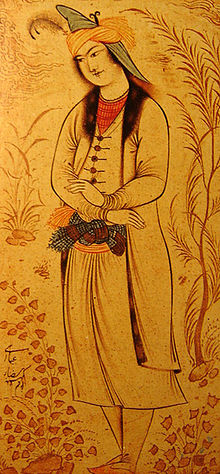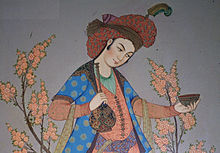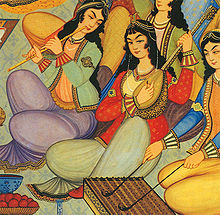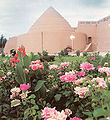- Culture of Iran
-
To best understand Iran, Afghanistan, their related societies and their people, one must first attempt to acquire an understanding of their culture. It is in the study of this area where the Persian identity optimally expresses itself. Hence the first sentence of prominent Iranologist Richard Nelson Frye's latest book on Persia reads:
- "Iran's glory has always been its culture." [1]
Persians were not only open to other cultures, but freely adapted to all they found useful. Thus an eclectic cultural elasticity has been said to be one of the key defining characteristics of the Persian spirit and a clue to its historic longevity.[2] Furthermore, Iran's culture has manifested itself in several facets throughout the history of Iran as well as that of Central Asia.
The article uses the words Persian and Iranian interchangeably, sometimes referring to the language and its speakers, and other times referring to the name of pre-20th century Iran, a nomenclature which survives from western explorers and orientalists. Both are not the same however, and the cultures of the peoples of Greater Persia are the focus of this article.
Contents
Art
Iranian art has gone through numerous phases of evolution. The unique aesthetics of Iran is evident from the Achaemenid reliefs in Persepolis to the mosaic paintings of Bishapur. The Islamic era drastically brought changes to the styles and practice of the arts, each dynasty with its own particular foci. The Qajarid era was the last stage of classical Persian art, before modernism was imported and suffused into elements of traditionalist schools of aesthetics.
Language and literature
There are several languages spoken in different parts of Iran. Mainly Persian across the country, Azerbaijani in northwest and central Iran, Kurdish in west part, Arabic in south west, Balochi in east and Turkmen mainly in north of Iran. Among these, the Turkish language's subsets is the largest group[citation needed] comparing others which covers all the northwest, main part of central and north east part of Iran. This is of course the effect of the multiethnic culture of Iran due to the extension of the previous Aryan (Iranian) empires. This is because Iranians by tradition are culturally tolerant (e.g. The Cyrus Cylinder) being described since the time of Herodotus as internalizing the best traits of outsiders. A reason for the Turkmen qualitative dominance[citation needed] among Iranian ethnic minorities is a result of the great Turkmen migration from the Altay which led to the coming of e.g. The Seljuq Empire, The Mongolian Empire, The Ottoman Empire to mention a few.
Ancient literature and historical records (with the exception of archaeological observations) are poorly preserved (e.g. the first national epos of Iran was first written by Ferdowsi in the First Millennium A.D. Over 1,500 years after the founding of the Hakhamaniyan Empire by Cyrus the Great the first Zoroastrian empire). This is an effect of the Arabian expansion which began with the Islamic prophet Muhammad. While the Mongols are often blamed for the destruction of Persian cultural dominance in the area, the Arabs and their allies were known to have destroyed libraries, historical sources, Zoroastrian fire temples and sculptures. These actions were a result of efforts to bring about the Arabification of Greater Iran, arguably doing more damage to Persian cultural integrity than the Mongol invasions.
Persian literature inspired Goethe, Ralph Waldo Emerson and many others, and it has been often dubbed as a most worthy language to serve as a conduit for poetry. Dialects of Persian are sporadically spoken throughout the region from China to Syria, though mainly in Iranian Plateau. Two important dialects of Persian serving as languages are Tajiki and Dari respectively spoken in Tajikistan and Afghanistan as official languages.
Contemporary Iranian literature is influenced by classical Persian poetry, but also reflects the particularities of modern day Iran, through writers such as Houshang Moradi-Kermani, the most translated modern Iranian author, and poet Ahmad Shamlou.[3]
Cinema
With 300 international awards in the past 10 years, films from Iran continue to be celebrated worldwide. Perhaps the best known director is Abbas Kiarostami.
Music
The music of Persia goes back to before the days of Barbod in the royal Sassanid courts. This is where many music cultures trace back their distant origins.
Architecture
Traditional teahouses of Iran
There are nearly countless numbers of traditional teahouses (chai khoneh) throughout Iran, and each province features its own unique cultural presentation of this ancient tradition. However, there are certain traits which are common to all teahouses, especially the most visible aspects, strong chai (tea) and the ever-present ghalyan hookah. Almost all teahouses serve baqleh, steam boiled fava beans (in the pod), served with salt and vinegar, as well as a variety of desserts and pastries. Many teahouses also serve full meals, typically a variety of kababs as well as regional specialities.
Persian gardens
The Persian Garden was designed as a reflection of paradise on earth; the word "garden" itself coming from Persian roots. The special place of the garden in the Iranian heart can be seen in their architecture, in the ruins of Iran, and in their paintings.
Cuisine
Examples of traditional Iranian food include chelo kabaab, khoreshte sabzi, dolmeh, and cotlet. Today in Iran you can find fast food restaurants serving pizza, hamburgers, chicken burgers, etc.
Sports
- The game of Polo originated with Iranian tribes in ancient times and was regularly seen throughout the country until the revolution of 1979 where it became associated with the monarchy. It continues to be played, but only in rural areas and discreetly. Recently, as of 2005, it has been acquiring an increasingly higher profile. In March 2006, there was a highly publicised tournament and all significant matches are now televised.
- The Iranian Zoor Khaneh
Women in Persian culture
In the tales of the 1001 Nights, it is a woman, Scheherazade, who is the protagonist and heroine of the frame tale.
Traditional important days
Iranians celebrate the following days based on a Solar calendar, in addition to important religious days of Islamic and Shia calendars, which are based on a lunar calendar.
- Nowruz (Iranian New Year) - Starts from 21 March
- Sizdah be dar (Nature Day)
- Jashn-e-Tirgan (Water Festival)
- Jashn-e-Sadeh (Fire Festival)
- Jashn-e-Mehregan (Autumn Festival)
- Shab-e-Yalda (Winter Feast)
- Charshanbeh Suri
Traditional cultural inheritors of the old Persia
 Prince Muhammad-Beik of Georgia, 1620. Artist is Reza Abbasi. Painting is located at Berlin's Museum Für Islamische Kunst.
Prince Muhammad-Beik of Georgia, 1620. Artist is Reza Abbasi. Painting is located at Berlin's Museum Für Islamische Kunst.
Like the Persian carpet that exhibits numerous colors and forms in a dazzling display of warmth and creativity, Persian culture is the glue that bonds the peoples of western and central Asia. The Caucasus and Central Asia "occupy an important place in the historical geography of Persian civilization. Much of the region was included in the Pre-Islamic Persian empires, and many of its ancient peoples either belonged to the Iranian branch of the Indo-European peoples (e.g. Medes and Soghdians), or were in close cultural contact with them (e.g. the Armenians).[4] In the words of Iranologist Richard Nelson Frye:
- "Many times I have emphasized that the present peoples of central Asia, whether Iranian or Turkic speaking, have one culture, one religion, one set of social values and traditions with only language separating them."
The Culture of Persia has thus developed over several thousand years. But historically, the peoples of Iran, Armenia , Azerbaijan, Turkey, Georgia , Tajikistan , Afghanistan, and Uzbekistan originate from the same or similar stock, and are related to one another as part of the larger group of peoples of Greater Iran. Southwestern Russia is well within the sphere of influence of Persian culture as well, as can be seen from the many remaining relics, ruins, and works of literature from that region.(e.g. 1) (e.g. 2)
In particular, Iran, Afghanistan, and Tajikistan have been able to almost fully retain their Persian identity, while the other aforementioned entities still exhibit considerable traces of their Iranian past.
Contributions to humanity in ancient history
From the humble brick, to the windmill, Persians have mixed creativity with art and offered the world numerous contributions.[5][6] What follows is a list of just a few examples of the cultural contributions of Greater Persia.
- (10,000 BC) - Earliest known domestication of the goat.[7]
- (6000 BC) - The modern brick.[8] Some of the oldest bricks found to date are Persian, from c. 6000 BC.
- (~5000 BC) - Invention of Wine. Discovery made by University of Pennsylvania excavations at Hajji Firuz Tepe in northwestern Iran.[9]
- (5000 BC) - Invention of the Tar (lute), which led to the development of the guitar.
- (3000 BC) - The ziggurat. The Sialk ziggurat, according to the Cultural Heritage Organization of Iran, predates that of Ur or any other of Mesopotamia's 34 ziggurats.
- (2500 BC) - First Banking System of the World, at the time of the Achaemenid, establishment of Governmental Banks to help farmers at the time of drought, floods, and other natural disasters in form of loans and forgiveness loans to restart their farms and husbandries. These Governmental Banks were effective in different forms until the end of Sassanian Empire before invasion of Arabs to Persia.
- (2500 BC) - The word Check has a Persian root in old Persian language. The use of this document as a check was in use from Achaemenid time to the end of Sassanian Empire. The word of [Bonchaq, or Bonchagh] in modern Persian language is new version of old Avestan and Pahlavi language "Check". In Persian it means a document which resembles money value for gold, silver and property. By law people were able to buy and sell these documents or exchange them.
- (2000 BC) - Peaches are a fruit of Iranian origin, as indicated by their Latin scientific name, Prunus persica, from which (by way of the French) we have the English word "peach."[10]
- Tulips were first cultivated in ancient Persia.[11]
- (1400 BC) - The game of Backgammon appears in the east of Iran.
- (1400 BC to 600 BC) - Zoroastrianism: where the first prophet of a monotheistic faith arose according to some scholars,[12] claiming Zoroastrianism as being "the oldest of the revealed credal religions, which has probably had more influence on mankind directly or indirectly, more than any other faith".[13][14]
- (576 BC to 529 BC) - Under the rule of Cyrus II the Great, the Cyrus Cylinder was issued. It was discovered in 1879 in Babylon and today is kept in the British Museum.
- (576 BC to 529 BC) - Under the rule of Cyrus II the Great, Cyrus frees the Jews from Babylonian captivity. See Cyrus in the Judeo-Christian tradition.
- (521 BC) - The game Polo.[15]
- (500 BC) - World's oldest Staple (fastener).
- (500 BC) - The first Taxation system (under the Achaemenid Empire).
- (500 BC) - The first courier post. Also called the "Royal Road".[16]
- (500 BC) - Source for introduction of the domesticated chicken into Europe.
- (500 BC) - First cultivation of spinach.
-
An ancient ice house, called a yakhchal, built in ancient times for storing ice during summers.
- (400 BC) - Yakhchals, ancient refrigerators. (See picture above)
- (400 BC) - Ice cream.[17]
- (250 BC) - According to archaeological digs, the Parthians created the world's first batteries. Their original use is still uncertain, though it is suspected that they were used for electroplating.
- (250 BC) Original excavation of a Suez Canal.[18]
- (271 AD) - The teaching hospital
- (700 AD) - The cookie.
- (700 AD) - The windmill.[19]
- (864 AD-930 AD) - First systematic use of alcohol in Medicine: Rhazes.[20]
- (1000 AD) - Introduction of paper to the west.[21]
- (935 - 1020) - Ferdowsi writes the Shahnama (Book of Kings) that resulted in the revival of Iranian culture and the expansion of the Iranian cultural sphere.
- (980 - 1037) - Avicenna, a physician, writes The Canon of Medicine one of the foundational manuals in the history of modern medicine.
- (1207 AD - 1273 AD) - Rumi writes poetry and in 1997, the translations were best-sellers in the United States.[22]
- Algebra and Trigonometry: Numerous Iranians were directly responsible for the establishment of Algebra, the advancement of Medicine and Chemistry, and the discovery of Trigonometry.[23]
- Qanat, subterranean aqueducts.
- Wind catchers, ancient air residential conditioning.
- "Virtually all European scholars claim Arabic music has Persian origins".[24]
See also
- International Rankings of Iran in Culture
- Afsaneh Art and Culture Society
- Cup of Jamshid
- Demography of Iran
- Encyclopædia Iranica (30-volume encyclopaedia of Iran's culture; edited and published by Columbia University & funded by the National Endowment for the Humanities)
- Flying Carpets
- Golha Radio Program
- Higher education in Iran
- Iranian calendar
- Iranian continent
- Iranian Studies
- List of Iranian scientists and scholars of the pre-modern age
- List of Persia-related topics
- Magus
- Media of Iran
- List of contemporary Iranian scientists, scholars, and engineers
- Persian food
- Persian names
- Persian wedding
- Persian women
- Persianate
- Persianization
- Persophilia the admiration of Iranians and their culture
- Taarof (Persian form of civility emphasizing both self-deference and social rank)
References
- ^ Greater Iran, Mazda Publishers, 2005. ISBN 1568591772 xi
- ^ Milani, A. Lost Wisdom. 2004.ISBN 0934211906 p.15
- ^ HOUSHMAND, Zara, "Iran", in Literature from the "Axis of Evil" (a Words Without Borders anthology), ISBN 978-1-59558-205-8, 2006, pp.1-3
- ^ Edmund Herzing, Iran and the former Soviet South, The Royal Institute of International Affairs, 1995, ISBN 1899658041 p.48
- ^ Iran's contribution to the world civilization. A.H. Nayer-Nouri. 1969. Tehran, General Dept. of Publications, Ministry of Culture and Arts. OCLC number: 29858074 Perry-Castañeda Library Reprinted in 1996 under the title: سهم ارزشمند ایران در فرهنگ جهان
- ^ "The effect of Persia's culture and civilization on the world" (Taʼ̲sīr-i farhang va tamaddun-i Īrān dar jahān). Abbās Qadiyānī (عباس قدياني). Tehran. 2005. Intishārāt-i Farhang-i Maktūb. ISBN 9649422447 OCLC 70237532
- ^ Link: http://web.utk.edu/~persian/goat.htm
- ^ Arthur Upham Pope, Persian Architecture, 1965, New York, p.15
- ^ Link: University of Pennsylvania http://www.museum.upenn.edu/new/research/Exp_Rese_Disc/NearEast/wine.shtml
- ^ Link: http://www.birdnature.com/nov1899/peach.html
- ^ Links:
- ^ Abbas Milani. Lost Wisdom. 2004. Mage Publishers. p.12. ISBN 0934211906
- ^ Mary Boyce, "Zoroastrians", London, 1979, 1.
- ^ Notes:
- Zoroastrianism had an important impact on Judaism, and thus indirectly, on Christianity and Islam.
- Zoroaster himself was not an ethnic Persian, but (possibly) an ethnic Bactrian who were closely related to Persians.
- ^ Link: BBC http://news.bbc.co.uk/2/hi/middle_east/4272210.stm
- ^ Links:
- ^ Links:
- ^ Links:
- ^ Links:
- ^ Link: http://www.free-definition.com/Abu-Bakr-Mohammad-Ibn-Zakariya-al-Razi.html
- ^ Link: http://web.utk.edu/~persian/paper.htm
- ^ Refer to article by the Christian Science Monitor - http://www.csmonitor.com/1997/1125/112597.us.us.3.html.
- ^ See:
- Hill, Donald. Islamic Science and Engineering. May 1994. Edinburgh University Press. p.10
- Sardar, Ziauddin. Introducing Mathematics. Totem Books. 1999.
- ^ The Golden Age of the Moor. By Ivan van Sertima. 1992. Transaction Publishers. ISBN 1560005815. p.17
-
Craftsmanship in Iranian Architecture. An excellent animation depicting the intricate details of the traditional interior design: (click).
Further reading
- Michael C. Hillman. Iranian Culture. 1990. University Press of America. ISBN 081917694X
- George Ghevarghese Joseph.The Crest of the Peacock: The Non-European Roots of Mathematics. July 2000. Princeton U Press.
External links
- Persian culture
- Pairidaeza, Iranian Culture Aggregator
- Culture of Iran on Iran Chamber Society
- Iran Online, Iran portal site
- Secretariat of The High Council of The Cultural Revolution
- Ministry of Culture and Islamic Guidance
- Islamic Republic of Iran Physical Education Organization
- Islamic Republic of Iran Academy of Sciences
- Islamic Republic of Iran Academy of The Arts
- "Persian undercurrent in Islamic civilization"
- Islamic Republic of Iran International Center for Diologue Among Civilizations
- Culture of Iran
- Cultural Research Bureau of Iran
- Iran Institute for Humanities and Cultural Studies
- Iran a cultural profile
- Forough Farrokhzad Poetry in English
- Underground Art Studio in Tehran
- The Culture of Iran
- Persian Language (Persian)
- World Zoroastrian News Network (WZNN) (News about Persian Zoroastrians)
- 10,000 Inventions Registered in Iran in 9 Months Fars News agency
Culture of Asia Sovereign
states- Afghanistan
- Armenia
- Azerbaijan
- Bahrain
- Bangladesh
- Bhutan
- Brunei
- Burma (Myanmar)
- Cambodia
- People's Republic of China
- Cyprus
- East Timor (Timor-Leste)
- Egypt
- Georgia
- India
- Indonesia
- Iran
- Iraq
- Israel
- Japan
- Jordan
- Kazakhstan
- North Korea
- South Korea
- Kuwait
- Kyrgyzstan
- Laos
- Lebanon
- Malaysia
- Maldives
- Mongolia
- Nepal
- Oman
- Pakistan
- Philippines
- Qatar
- Russia
- Saudi Arabia
- Singapore
- Sri Lanka
- Syria
- Tajikistan
- Thailand
- Turkey
- Turkmenistan
- United Arab Emirates
- Uzbekistan
- Vietnam
- Yemen
States with limited
recognition- Abkhazia
- Nagorno-Karabakh
- Northern Cyprus
- Palestine
- Republic of China (Taiwan)
- South Ossetia
Dependencies and
other territoriesCategories:- Iranian culture
Wikimedia Foundation. 2010.







